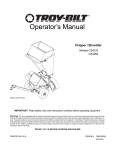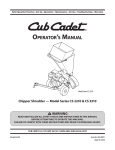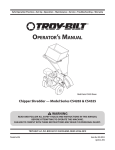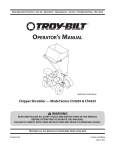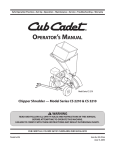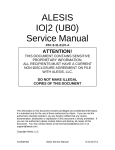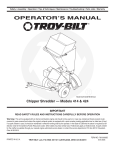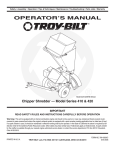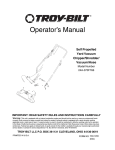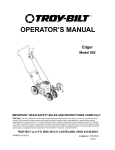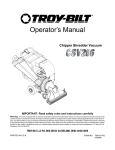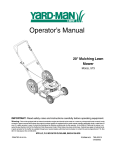Download Troy-Bilt CS4210, CS4265 Chipper User Manual
Transcript
Operator’s Manual Chipper / Shredder Models CS4210 CS4265 Model CS4210 Shown IMPORTANT: READ SAFETY RULES AND INSTRUCTIONS CAREFULLY Warning: This unit is equipped with an internal combustion engine and should not be used on or near any unimproved forest-covered, brushcovered or grass-covered land unless the engine’s exhaust system is equipped with a spark arrester meeting applicable local or state laws (if any). If a spark arrester is used, it should be maintained in effective working order by the operator. In the State of California the above is required by law (Section 4442 of the California Public Resources Code). Other states may have similar laws. Federal laws apply on federal lands. A spark arrester for the muffler is available through your nearest engine authorized service dealer or contact the service department, P.O. Box 361131 Cleveland, Ohio 44136-0019. MTD LLC P.O. BOX 361131 CLEVELAND, OHIO 44136-0019 PRINTED IN U.S.A. FORM NO. 769-00830.fm (7/03) TABLE OF CONTENTS Content Page Important Safe Operation Practices ........................................................................ 3 Assembling Your Chipper Shredder ........................................................................ 5 Know Your Chipper Shredder.................................................................................. 6 Operating Your Chipper Shredder .......................................................................... 7 Maintaining Your Chipper Shredder ....................................................................... 9 Troubleshooting ...................................................................................................... 12 Parts List ................................................................................................................. 13 FINDING MODEL NUMBER This Operator’s Manual is an important part of your new chipper shredder. It will help you assemble, prepare and maintain the unit for best performance. Please read and understand what it says. Before you start assembling your new equipment, please locate the model plate on the equipment and copy the information from it in the space provided below. The information on the model plate is very important if you need help from our Customer Support Department or an authorized dealer. • You can locate the model number by standing behind the unit and looking down at the frame below the engine. A sample model plate is explained below. For future reference, please copy the model number and the serial number of the equipment in the space below. Copy the model number here: www.troybilt.com TROY-BILT LLC P. O. BOX 3 6 1 1 3 1 CLEVELAND, OH 44136 330-558-7220 866-840-6483 Copy the serial number here: ENGINE INFORMATION The engine manufacturer is responsible for all engine-related issues with regard to performance, power-rating, specifications, warranty and service. Please refer to the engine manufacturer’s Owner’s/Operator’s Manual packed separately with your unit for more information. CALLING CUSTOMER SUPPORT Please do NOT return the unit to the retailer from which it was purchased, without first contacting Customer Support. Should you have difficulty assembling this product or have any questions regarding the controls, operation or maintenance of this unit, please call the Customer Support Department. Call 1- (330) 558-7220 or 1- (888)-840-6483 to reach a Customer Support representative. Please have your unit’s model number and serial number ready when you call. See previous section to locate this information. You will be asked to enter the serial number in order to process your call. For more details about your machine, visit our website at www.troy-bilt.com 2 SECTION 1: IMPORTANT SAFE OPERATION PRACTICES WARNING: This symbol points out important safety instructions which, if not followed, could endanger the personal safety and/or property of yourself and others. Read and follow all instructions in this manual before attempting to operate this machine. Failure to comply with these instructions may result in personal injury. When you see this symbol - heed its warning. WARNING: The Engine Exhaust from this product contains chemicals known to the State of California to cause cancer, birth defects or other reproductive harm. DANGER: This machine was built to be operated according to the rules for safe operation in this manual. As with any type of power equipment, carelessness or error on the part of the operator can result in serious injury. This machine is capable of amputating hands and feet and throwing objects. Failure to observe the following safety instructions could result in serious injury or death. TRAINING 2. Always wear safety glasses or safety goggles during operation or while performing an adjustment or repair, to protect eyes. Thrown objects which ricochet can cause serious injury to the eyes. 3. Wear sturdy, rough-soled work shoes and closefitting slacks and shirts. Loose fitting clothes or jewelry can be caught in movable parts. Never operate this machine in bare feet or sandals. Wear leather work gloves when feeding material in the chipper chute. 4. Before starting, check all bolts and screws for proper tightness to be sure the machine is in safe working condition. Also, visually inspect machine for any damage at frequent intervals. 5. Maintain or replace safety and instructions labels, as necessary. 6. To avoid personal injury or property damage use extreme care in handling gasoline. Gasoline is extremely flammable and the vapors are explosive. Serious personal injury can occur when gasoline is spilled on yourself or your clothes which can ignite. Wash your skin and change clothes immediately. a. Use only an approved gasoline container. b. Extinguish all cigarettes, cigars, pipes, and other sources of ignition. c. Never fuel machine indoors. d. Never remove gas cap or add fuel while the engine is hot or running. e. Allow engine to cool at least two minutes before refueling. f. Never over fill fuel tank. Fill tank to no more than 1/2 inch below bottom of filler neck to provide space for fuel expansion. g. Replace gasoline cap and tighten securely. h. If gasoline is spilled, wipe it off the engine and equipment. Move machine to another area. Wait five (5) minutes before starting the engine. 1. Read, understand, and follow all instructions on the machine and in the manual(s) before attempting to assemble and operate. Keep this manual in a safe place for future and regular reference and for ordering replacement parts. 2. Be familiar with all controls and their proper operation. Know how to stop the machine and disengage them quickly. 3. Never allow children under 16 years old to operate this machine. Children 16 years old and over should read and understand the operation instructions and safety rules in this manual and should be trained and supervised by a parent. 4. Never allow adults to operate this machine without proper instruction. 5. Keep bystanders, helpers, pets, and children at least 75 feet from the machine while it is in operation. Stop machine if anyone enters the area. 6. Never run an engine indoors or in a poorly ventilated area. Engine exhaust contains carbon monoxide, an odorless and deadly gas. 7. Do not put hands and feet near rotating parts or in the feeding chambers and discharge opening. Contact with the rotating impeller can amputate fingers, hands, and feet. 8. Never attempt to unclog either the feed intake or discharge opening, remove or empty bag, or inspect and repair the machine while the engine is running. Shut the engine off and wait until all moving parts have come to a complete stop. Disconnect the spark plug wire and ground it against the engine. PREPARATION 1. Thoroughly inspect the area where the equipment is to be used. Remove all rocks, bottles, cans, or other foreign objects which could be picked up or thrown and cause personal injury or damage to the machine. 3 9. Never operate without the shredder hopper, chipper chute, or discharge chute properly attached to the machine. Never empty or change discharge bag while the engine is running. 10. Keep all guards, deflectors and safety devices in place and operating properly. 11. Keep your face and body back and to the side of the chipper chute while feeding material into the machine to avoid accidental kickback injuries. 12. Never operate this machine without good visibility or light. 13. Do not operate this machine on a paved, gravel or non-level surface. 14. Do not operate this machine while under the influence of alcohol or drugs. 15. Muffler and engine become hot and can cause a burn. Do not touch. 16. Never pick up or carry machine while the engine is running. i. Never store the machine or fuel container inside where there is an open flame, spark, or pilot light (e.g. furnace, water heater, space heater, clothes dryer, etc.) j. To reduce a fire hazard, keep machine free of grass, leaves, or other debris build-up. Clean up oil or fuel spillage and remove any fuel soaked debris. k. Allow machine to cool at least 5 minutes before storing. OPERATION 1. Do not put hands and feet near rotating parts or in the feeding chambers and discharge opening. Contact with the rotating impeller can amputate fingers, hands, and feet. 2. Before starting the machine, make sure the chipper chute, feed intake, and cutting chamber are empty and free of all debris. 3. Thoroughly inspect all material to be shredded and remove any metal, rocks, bottles, cans, or other foreign objects which could cause personal injury or damage to the machine. 4. If it becomes necessary to push material through the shredder hopper, use a small diameter stick. Do not use your hands or feet. 5. If the impeller strikes a foreign object or if your machine should start making an unusual noise or vibration, immediately shut the engine off. Allow the impeller to come to a complete stop. Disconnect the spark plug wire, ground it against the engine and perform the following steps: a. Inspect for damage. b. Repair or replace any damaged parts. c. Check for any loose parts and tighten to assure continued safe operation. 6. Do not allow an accumulation of processed material to build up in the reduction chamber. This can prevent proper discharge and result in kickback of material through the feed opening. 7. Do not attempt to shred or chip material larger than specified on the machine or in this manual. Personal injury or machine damage could result. 8. Never attempt to unclog either the feed intake or discharge opening while the engine is running. Shut the engine off, wait until all moving parts have stopped, disconnect the spark plug wire and ground it against the engine before clearing debris. MAINTENANCE AND STORAGE 1. Never tamper with safety devices. Check their proper operation regularly. 2. Check bolts and screws for proper tightness at frequent intervals to keep the machine in safe working condition. Also, visually inspect machine for any damage and repair, if needed. 3. Before cleaning, repairing, or inspecting, stop the engine and make certain the impeller and all moving parts have stopped. Disconnect the spark plug wire and ground it against the engine to prevent unintended starting. 4. Do not change the engine governor settings or overspeed the engine. The governor controls the maximum safe operating speed of the engine. 5. Maintain or replace safety and instruction labels, as necessary. 6. Follow this manual for safe loading, unloading, transporting, and storage of this machine. 7. Never store the machine or fuel container inside where there is an open flame, spark or pilot light such as a water heater, furnace, clothes dryer, etc. 8. Always refer to the operator’s manual for proper instructions on off-season storage. 9. If the fuel tank has to be drained, do this outdoors. 10. Observe proper disposal laws and regulations for gas, oil, etc. to protect the environment. WARNING: - YOUR RESPONSIBILITY: Restrict the use of this power machine to persons who read, understand and follow the warnings and instructions in this manual and on the machine. 4 SAFETY LABELS FOUND ON YOUR UNIT SECTION 2: ASSEMBLING YOUR CHIPPER SHREDDER IMPORTANT: This unit is shipped without gasoline or oil in the engine. Be certain to service engine with gasoline and oil as instructed in the Briggs & Stratton Owner/ Operator manual packed with your unit. before operating your machine. 1. Loose Parts In Carton • • • • Spring Latch Tow Bar (Model CS4210 Only) Debris Collection Bag Safety Glasses Engine Oil (one 20 oz. bottle) 2. Lock Rod Lowering the Chipper Chute For shipping reasons, the unit is crated with its chipper chute in a raised position. To pivot it downward, proceed as follows: • Pull the spring latch upward and gently pivot the chipper chute down until it clicks into the lock rod. See Figure 1. Figure 1 WARNING: Never operate the chipper shredder with the chipper chute in the raised position. Doing so may result in property damage or serious injury to the operator or bystanders. 5 Attaching The Debris Collection Bag Attaching The Tow Bar (Model CS4210 Only) • • • • To attach the bag, place the opening of the bag completely over the discharge chute. Position the bag so that the wing knobs which secure the discharge chute to the impeller housing are completely covered. Pull on the drawstrap until the bag is tight around discharge chute opening. To attach the tow bar, remove the spring pin and clevis pin from the end of the tongue. See Figure 3. Spring Pin Tongue Base Clevis Pin Figure 3 • Debris Collection Bag Figure 2 • Insert the tongue into the base. Reinsert the clevis pin through aligning holes in both the tongue and the base. Fasten with the spring pin to secure. SECTION 3: KNOW YOUR CHIPPER SHREDDER Read this operator’s manual and safety rules before operating your chipper shredder. Compare the illustrations in Figure 4 with your unit to familiarize yourself with the location of various controls and adjustments. Save this manual for future reference. Lock Rod Engine Controls Branches up to 3” in diameter may be fed into the chipper chute for chipping. See Figure 4. The lock rod is located on the chipper chute support. It is used to release or lock the chipper chute in a lowered position for operation. See Figure 4. Chipper Chute See the Briggs & Stratton Owner/Operator manual packed with your unit. for the location and function of the controls on the engine. Hopper Leaves, twigs and branches up to 1/2-inch in diameter may be placed into the hopper for shredding. See Figure 4. Starter Handle The starter handle is located on the engine. Pull the starter handle to start engine. See Figure 4. IMPORTANT: Never place branches with a diameter Spring Latch greater than 1/2-inch in the hopper. Doing so can result in serious damage to your unit’s shredder blade, flails or impeller. The spring latch is located on the top of the hopper. It is used to release or lock the chipper chute in a raised position for storage or for transporting. See Figure 4. Handle WARNING: Never operate the chipper shredder with the chipper chute in the raised position. Use the spring latch to lower the chipper chute into the operating position before starting the engine. Use the handle when manually transporting the chipper shredder. 6 Handle Hopper Chipper Chute Spring Latch Starter Handle Discharge Chute Wing Knob Two Bar (Model CS4210 Only) Lock Rod Figure 4 SECTION 4: OPERATING YOUR CHIPPER SHREDDER • WARNING: The operation of any chipper shredder can result in foreign objects being thrown. Always wear the safety glasses provided with this unit or eye shields before chipping or shredding and while performing any adjustments or repairs. • OPEN NOTE: (A warm engine may not require choking). Gas And Oil Fill-Up • Service the engine with gasoline and oil as instructed in the separate engine manual packed with your chipper shredder. Read instructions carefully. WARNING: Never fill fuel tank indoors with engine running or until the engine has been allowed to cool for at least two minutes after running. Starting Engine • Open fuel shut-off valve (Model CS4210). Move choke control lever to CHOKE position (Models CS4210 & CS4265) . Attach spark plug wire to spark plug. Make certain the metal cap on the end of the spark plug is fastened securely over the metal tip on the spark plug. 7 Move throttle control lever to FAST (rabbit) position (Model CS4265). • Observe the following guidelines when shredding yard debris: Grasp the starter handle and pull the rope out slowly until resistance is felt. When it becomes slightly harder to pull the rope, slowly allow the rope to recoil. Then pull rope with a rapid, continuous, full arm stroke. Keep a firm grip on starter handle. • • NOTE: A “clanking” noise may be heard when pulling the starter rope. It is completely normal and does NOT indicate a malfunction of any kind. • • • Maintain a grip on the starter handle and allow the rope to recoil slowly. Repeat the previous steps until engine starts. When engine starts, move choke control gradually toward the RUN position until the engine is running smoothly. • • WARNING: Never run the engine indoors or in a poorly ventilated area. Engine exhaust contains carbon monoxide, an odorless and deadly gas. IMPORTANT: Never place branches with a diameter greater than 1/2-inch in the hopper. Doing so can result in serious damage to your unit’s shredder blade, flails or impeller. Stopping Engine • Never attempt to shred material other than normal yard debris (leaves, twigs, pine cones, etc.). Avoid shredding fibrous plants such as tomato vines until they are thoroughly dried out. Fresh vines do not shred well and tend to wrap themselves around the impeller and flails. Place reasonable amounts of debris into the hopper at a time. Do not overload the hopper. Allow the material in the hopper to be drawn into the blades and shredded before adding additional debris to the hopper. Failure to due so may result in a clogged hopper, clogged discharge chute or a stalled engine. Avoid placing twigs longer than 24 inches into the hopper. Twigs longer than 24 inches may result in a clogged hopper. Move throttle control lever to STOP position (Model CS4265) or push rocker switch to OFF (Model CS4210). See Figure 5. Clearing the Hopper Should the hopper become clogged with debris during operation, proceed as follows: • Grasp the handle with both hands and gently agitate the chipper shredder to help loosen debris, drawing it into the impeller. If the clog does not clear, proceed as follows: • • • • Stop engine. Use your hands to remove any debris found near the top of the hopper . Use a branch (or other available device, i.e. broomstick) to dislodge debris located toward the base of the hopper. Restart engine. NOTE: If you’re unable to pull the starter rope as a result of accumulated debris near the impeller, follow instructions under the heading Cleaning the Reduction Chamber. Figure 5 Chipping CAUTION: Never stop the engine by moving the choke lever into the CHOKE position. Backfire, fire or engine damage could result. WARNING: Never operate the chipper shredder without chipper chute lowered into the operating position. Operating the Chipper Shredder Branches up to 3” in diameter can be fed into the chipper chute. See Figure 4. Observe the following guidelines when chipping branches: Shredding Yard waste such as leaves and pine needles can be placed in the hopper for shredding. After material has been processed by the shredder blade and flails, it will be forced out of the discharge chute, and, if attached, into a debris collection bag. • • • 8 Keep both hands firmly on the branch as you feed it into the chipper chute. Never feed more than one branch into the chipper chute at a time. Never feed anything other than branches (or wood) into the chipper chute. • • Use the tamper to assist in feeding branches into the chipper chute. Apply intermittent pressure (force, in short pulses) while feeding larger (2- 3-inch diameter) branches into the chipper chute, to avoid bogging or stalling the engine. Locking Buckle IMPORTANT: Never feed branches with a diameter greater than three (3) inches into the chipper chute. Doing so can result in serious damage to your unit’s chipper blades, flails or impeller. NOTE: For best performance, always operate the unit with sharp chipper blades. If a noticeable loss in performance is encountered while chipping branches, the chipper blades should be replaced. Emptying the Debris Collection Bag • • Stop engine. Squeeze the locking buckle release the bag’s drawstrap before loosening it from the discharge chute. See Figure 6. Figure 6 • Empty the bag and reattach to the discharge chute opening. Refer to Figure 2. SECTION 5: MAINTAINING YOUR CHIPPER SHREDDER ag e tor as es for SERVICE DATES Be On c ea se 00 er y1 Ev on rs s ou r ho u s 0h ou r er y5 Ev er y2 ea re Be fo SCHEDULE Ev MAINTENANCE 5h ch us e Customer Responsibilities PRODUCT Lube Spring Latch Lube Chipper Chute Hinge Lube Discharge Chute Inspect Chipper Blades Inspect Shredder Blade Inspect for Loose Hardware Check Oil Level ENGINE Change Oil Clean Air Filter Precleaner Clean Engine Check Spark Plug Lubrication WARNING: Always stop engine, disconnect spark plug, and ground against engine before cleaning, lubricating or doing any kind of maintenance on your machine. Chipper Chute Hinge: Lubricate the hinge a with light oil once a season. 9 Discharge Chute: Lubricate the pivot points on the chute deflector with light oil once a season. Discharge Chute Engine: Refer to the Briggs & Stratton Owner/Operator manual packed with your unit for lubrication instructions. Shredder Screen Hairpin Clip Maintenance Housing Engine Refer to the Maintenance section of the Briggs & Stratton Owner/Operator manual packed with your unit. Read and follow instructions carefully • • • Clevis Pin Check engine oil level before each use as instructed in the separate engine manual. Clean air cleaner’s precleaner every 25 hours under normal conditions. Clean every few hours under extremely dusty conditions. Replace the air cleaner cartridge once a season. To service the air cleaner, refer to the separate engine manual. The spark plug should be cleaned and the gap reset once a season. Refer to the separate engine manual for correct plug type and gap specifications. Wing Knobs Reduction Chamber Figure 8 • • Chipper Shredder • Before each use, visually inspect your chipper shredder for loose (or missing) nuts and bolts. Securely tighten (or replace) all hardware before operating the chipper shredder. • Cleaning the Reduction Chamber Replacing the Chipper Blades WARNING: The impeller’s shredder blade and chipper blades are sharp. Wear leather work gloves to protect your hands when cleaning out the reduction chamber. WARNING: The impeller’s chipper blades are sharp. Wear leather work gloves to protect your hands. • If the reduction chamber becomes clogged with debris, the shredder screen can be pivoted upward so that you can clean the surrounding area. To do so, proceed as follows: • • • • Stop the engine and wait untill all moving parts have come to a complete stop. Disconnect spark plug wire and keep away from spark plug. • WARNING: The muffler and surrounding area will be hot if the engine has been running. Use caution and protect your hands if working near the muffler. • • • Confirm that the spark plug wire is disconnected and away from spark plug. Pull on the starter rope two-to-three times to purge any remaining debris from the reduction chamber When the area is cleaned, pivot the shredder screen downward and re-secure with the clevis pin and hairpin clip removed earlier. Reattach the debris collection bag to the discharge chute, if desired. • • Remove the two wing knobs on either side of the discharge chute and pivot the discharge chute upward. See Figure 8. Remove the hairpin clip from the clevis pin which extends through the housing and shredder screen. See Figure 8. Retain the clevis pin and hairpin clip. Pivot the shredder screen upward and clean the surrounding area by scraping away debris. • 10 Stop the engine and make certain the chipper shredder has come to a complete stop. Disconnect spark plug wire and keep away from spark plug. Pivot the shredder screen upward as instructed under the heading Cleaning the Reduction Chamber. Remove the chipper chute support brace from the frame by removing the two hex bolts and saddle washers which secure it. See Figure 9. Remove the chipper chute by removing three hex nuts and washers which secure it to the impeller housing. See Figure 9. Rotate the impeller by hand until one of the two chipper blades is visible through the impeller housing opening. Remove the blade by removing the internal hex screws, lock washers and hex nuts which secure it to the impeller. Retain the hardware. Chipper Blade Lock Washer & Nut Support Bracket Flange Nuts Support Brace Impeller Internal Hex Screw Hex Bolts & Saddle Washers Figure 10 Figure 9 NOTE: Use a 3/16” hex key (Allen) wrench on the outside of the blade and a 1/2” box (or socket) wrench on the inside of the impeller. See Figure 9. Hold the Allen wrench stationary and rotate the box (or socket) wrench to loosen the nut. • Discharge Chute Shredder Blade Internal Hex Screws Install a replacement blade (Part No. 742-0544) with the hardware removed earlier. IMPORTANT: Make certain blades are reassembled with the sharp edge outward (toward the chipper chute). Torque hardware to between 20 ft-lbs and 25 ft-lbs. • Impeller Inlet Guide To replace the other blade, rotate the impeller to expose the second blade and repeat the steps above. Weld Studs Replacing the Shredder Blade • • • • • Hex Bolt, Lock Washer & Flat Washer Figure 11 WARNING: The impeller’s chipper blades are sharp. Wear leather work gloves to protect your hands. • Flange Nuts • Stop the engine and make certain that all moving parts have come to a complete stop. Remove the two flange nuts (and hex bolts) which secure the hopper support bracket to the impeller housing. Retain the hardware. See Figure 10. Pivot the shredder screen upward as instructed under the heading Cleaning the Reduction Chamber. Remove the six flange nuts which secure the hopper inlet guide to the impeller housing. See Figure 11. Carefully separate the hopper assembly from the impeller housing and set it aside. Insert a piece of wood into the discharge chute opening to stabilize the impeller and prevent it from rotating when removing the shredder blade. Remove the two internal hex screws which secure the shredder blade to the impeller. See Figure 11. NOTE: Use a 3/16” hex key (Allen) wrench on the outside of the shredder blade and a 1/2” box (or socket) wrench on the inside of the shredder blade. See Figure 11. Hold the Allen wrench stationary and rotate the box (or socket) wrench to loosen the nut. • Remove the hex bolt, lock washer, and flat washer to completely free the shredder blade. IMPORTANT: If sharpening the blade for reuse, follow the original angle of grind as a guide. Make certaineach cutting edge receives an equal amount of grinding to prevent an unbalanced blade. Remove metal from the heavy side until it is balanced evenly. IMPORTANT: When reassembling the blade, tighten center bolt to between 45 ft-lbs and 60 ft-lbs and the two out bolts to between 20 ft-lbs and 25 ft-lbs. 11 Storing Your Chipper Shredder • • • • Clean the equipment thoroughly. Wipe equipment with an oiled rag to prevent rust. Refer to engine manual for correct engine storage instructions Store unit in a clean, dry area. Do not store next to corrosive materials such as fertilizer. SECTION 6: TROUBLESHOOTING Problem Cause Remedy 1. Spark plug wire disconnected. 2. Fuel tank empty or stale fuel. 3. Throttle control lever (if equipped) not in correct starting position. 4. Choke not in CHOKE position. (If Equipped) 5. Blocked fuel line. 6. Faulty spark plug. 1. Connect wire to spark plug. 2. Fill tank with clean, fresh gasoline. 3. Move throttle lever to FAST position. 1. Spark plug wire loose. 2. Unit running on CHOKE. 3. Blocked fuel line or stale fuel. 4. Water or dirt in fuel system. 5. Dirty air cleaner. 6. Carburetor out of adjustment. 1. Connect and tighten spark plug wire. 2. Move choke lever to OFF position. 3. Clean fuel line; fill tank with clean, fresh gasoline 4. Drain fuel tank. Refill with fresh fuel. 5. Clean or replace air cleaner. 6. See authorized service dealer. Too much vibration 1. Loose parts or damaged impeller. 1. See authorized service dealer. Engine overheats 1. Engine oil level low. 2. Dirty air cleaner. 3. Carburetor not adjusted properly. 1. Fill crankcase with proper oil. 2. Clean or replace air cleaner. 3. See authorized service dealer. Engine fails to start Engine runs erratic 4. Move choke to CHOKE position. 5. Clean fuel line. 6. Clean, adjust gap, or replace. Occasional skip (hesitates) 1. Spark plug gap too close. at high speed 1. Adjust gap to.030” (0.76 mm) Unit does not discharge 1. Stop engine immediately and disconnect spark plug wire. Clean flail screen and inside of discharge opening. 2. Stop engine and disconnect spark plug wire. Remove lodged object. 3. Always run engine at full throttle. 1. Discharge chute clogged. 2. Foreign object lodged in impeller. 3. Low engine RPM. 1. Low engine RPM. Rate of discharge slows considerably or composition of discharged 2. Chipper blade dull. material changes. 1. Always run engine with the throttle (if so equipped) in the FAST position. 2. Replace chipper blade or see your authorized service dealer. NOTE: For repairs beyond the minor adjustments listed above, contact your nearest authorized service dealer. 12 MANUFACTURER’S LIMITED WARRANTY FOR: The limited warranty set forth below is given by Troy-Bilt LLC with respect to new merchandise purchased and used in the United States, its possessions and territories. “Troy-Bilt” warrants this product against defects in material and workmanship for a period of two (2) years commencing on the date of original purchase and will, at its option, repair or replace, free of charge, any part found to be defective in materials or workmanship. This limited warranty shall only apply if this product has been operated and maintained in accordance with the Operator’s Manual furnished with the product, and has not been subject to misuse, abuse, commercial use, neglect, accident, improper maintenance, alteration, vandalism, theft, fire, water, or damage because of other peril or natural disaster. Damage resulting from the installation or use of any part, accessory or attachment not approved by Troy-Bilt for use with the product(s) covered by this manual will void your warranty as to any resulting damage. Normal wear parts or components thereof are subject to separate terms as follows: All normal wear parts or component failures will be covered on the product for a period of 90 days regardless of cause. After 90 days, but within the two year period, normal wear part failures will be covered ONLY IF caused by defects in materials or workmanship of OTHER component parts. Normal wear parts and components include, but are not limited to: batteries, belts, blades, blade adapters, grass bags, rider deck wheels, seats, snow thrower skid shoes, shave plates, auger spiral rubber, and tires. HOW TO OBTAIN SERVICE: Warranty service is available, WITH PROOF OF PURCHASE, through your local authorized service dealer. To locate the dealer in your area, check your Yellow Pages, or contact Troy-Bilt LLC at P.O. Box 361131, Cleveland, Ohio 44136-0019, or call 1-866-840-6483 or 1330-558-7220, or log on to our Web site at www.troybilt.com. This limited warranty does not provide coverage in the following cases: a. Engine or components thereof. These items may carry a separate manufacturer’s warranty. Refer to applicable manufacturer’s warranty for terms and conditions. b. Log splitter pumps, valves, and cylinders have a separate one year warranty. c. Routine maintenance items such as lubricants, filters, blade sharpening, tune-ups, brake adjustments, clutch adjustments, deck adjustments, and normal deterioration of the exterior finish due to use or exposure. d. Troy-Bilt does not extend any warranty for products sold or exported outside of the United States, its possessions and territories, except those sold through Troy-Bilt’s authorized channels of export distribution. e. Replacement parts that are not genuine Troy-Bilt parts. f. Service completed by someone other than an authorized service dealer. g. Transportation charges and service calls. No implied warranty, including any implied warranty of merchantability of fitness for a particular purpose, applies after the applicable period of express written warranty above as to the parts as identified. No other express warranty, whether written or oral, except as mentioned above, given by any person or entity, including a dealer or retailer, with respect to any product, shall bind Troy-Bilt. During the period of the warranty, the exclusive remedy is repair or replacement of the product as set forth above. The provisions as set forth in this warranty provide the sole and exclusive remedy arising from the sale. Troy-Bilt shall not be liable for incidental or consequential loss or damage including, without limitation, expenses incurred for substitute or replacement lawn care services or for rental expenses to temporarily replace a warranted product. Some states do not allow the exclusion or limitation of incidental or consequential damages, or limitations on how long an implied warranty lasts, so the above exclusions or limitations may not apply to you. In no event shall recovery of any kind be greater than the amount of the purchase price of the product sold. Alteration of safety features of the product shall void this warranty. You assume the risk and liability for loss, damage, or injury to you and your property and/or to others and their property arising out of the misuse or inability to use the product. This limited warranty shall not extend to anyone other than the original purchaser or to the person for whom it was purchased as a gift. HOW STATE LAW RELATES TO THIS WARRANTY: This limited warranty gives you specific legal rights, and you may also have other rights which vary from state to state. IMPORTANT: Owner must present Original Proof of Purchase to obtain warranty coverage. Troy-Bilt LLC, P.O. BOX 361131 CLEVELAND, OHIO 44136-0019; Phone: 1-866-840-6483, 1-330-558-7220













